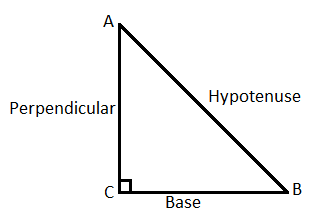
If ABC is an isosceles triangle, right angled at C. Then prove that \[{\left( {AB} \right)^2} = 2{\left( {AC} \right)^2}\].
Answer
596.4k+ views
Hint:Let us draw the isosceles triangle and then use Pythagorean theorem which states that \[{\left( {{\text{Hypotenuse}}} \right)^2} = {\left( {{\text{Perpendicular}}} \right)^2} + {\left( {{\text{Base}}} \right)^2}\].
Complete step-by-step answer:

ABC is the isosceles triangle
As we know that isosceles triangles are those triangles whose length of two sides are the same.
And as it is given that ABC is also a right-angle triangle, right-angles at C.
And as we know, that side opposite to the largest angle (90 degrees) in a right-angled triangle is known as the hypotenuse of the triangle. And the hypotenuse of the triangle is greater than the base and the perpendicular of the triangle.
So, if the triangle is isosceles and also a right-angled triangle then its perpendicular and base must be equal.
So, AB will be the hypotenuse of the above triangle ABC.
And AC and CB will be the perpendicular and base of triangle ABC.
So, AC = CB
Now as we know that according two Pythagorean Theorem for a right-angled triangle \[{\left( {{\text{Hypotenuse}}} \right)^2} = {\left( {{\text{Perpendicular}}} \right)^2} + {\left( {{\text{Base}}} \right)^2}\].
So, if XYZ is a right-angle triangle, right-angled at Y, then \[{\left( {XZ} \right)^2} = {\left( {{\text{XY}}} \right)^2} + {\left( {{\text{YZ}}} \right)^2}\].
So, applying Pythagorean Theorem in triangle ABC. We get,
\[{\left( {AB} \right)^2} = {\left( {AC} \right)^2} + {\left( {CB} \right)^2}\]
Now, as we know that AC = CB. So, above equation can be written as,
\[{\left( {AB} \right)^2} = {\left( {AC} \right)^2} + {\left( {AC} \right)^2}\]
\[{\left( {AB} \right)^2} = 2{\left( {AC} \right)^2}\]
Hence, if ABC is an isosceles triangle, right angled at C then \[{\left( {AB} \right)^2} = 2{\left( {AC} \right)^2}\].
Note:- Whenever we come up with this type of problem, we should remember that if a right-angle triangle is also an isosceles triangle then its perpendicular and base must be equal. And the hypotenuse of a right-angle triangle is always greater and different from the other sides of the triangle because the side opposite to the largest angle is greatest.
Complete step-by-step answer:

ABC is the isosceles triangle
As we know that isosceles triangles are those triangles whose length of two sides are the same.
And as it is given that ABC is also a right-angle triangle, right-angles at C.
And as we know, that side opposite to the largest angle (90 degrees) in a right-angled triangle is known as the hypotenuse of the triangle. And the hypotenuse of the triangle is greater than the base and the perpendicular of the triangle.
So, if the triangle is isosceles and also a right-angled triangle then its perpendicular and base must be equal.
So, AB will be the hypotenuse of the above triangle ABC.
And AC and CB will be the perpendicular and base of triangle ABC.
So, AC = CB
Now as we know that according two Pythagorean Theorem for a right-angled triangle \[{\left( {{\text{Hypotenuse}}} \right)^2} = {\left( {{\text{Perpendicular}}} \right)^2} + {\left( {{\text{Base}}} \right)^2}\].
So, if XYZ is a right-angle triangle, right-angled at Y, then \[{\left( {XZ} \right)^2} = {\left( {{\text{XY}}} \right)^2} + {\left( {{\text{YZ}}} \right)^2}\].
So, applying Pythagorean Theorem in triangle ABC. We get,
\[{\left( {AB} \right)^2} = {\left( {AC} \right)^2} + {\left( {CB} \right)^2}\]
Now, as we know that AC = CB. So, above equation can be written as,
\[{\left( {AB} \right)^2} = {\left( {AC} \right)^2} + {\left( {AC} \right)^2}\]
\[{\left( {AB} \right)^2} = 2{\left( {AC} \right)^2}\]
Hence, if ABC is an isosceles triangle, right angled at C then \[{\left( {AB} \right)^2} = 2{\left( {AC} \right)^2}\].
Note:- Whenever we come up with this type of problem, we should remember that if a right-angle triangle is also an isosceles triangle then its perpendicular and base must be equal. And the hypotenuse of a right-angle triangle is always greater and different from the other sides of the triangle because the side opposite to the largest angle is greatest.
Recently Updated Pages
Master Class 9 Social Science: Engaging Questions & Answers for Success

Master Class 9 Science: Engaging Questions & Answers for Success

Master Class 9 Maths: Engaging Questions & Answers for Success

Master Class 9 General Knowledge: Engaging Questions & Answers for Success

Class 9 Question and Answer - Your Ultimate Solutions Guide

Master Class 9 English: Engaging Questions & Answers for Success

Trending doubts
Which places in India experience sunrise first and class 9 social science CBSE

Which is the largest Gulf in the world A Gulf of Aqaba class 9 social science CBSE

Fill the blanks with the suitable prepositions 1 The class 9 english CBSE

Write the 6 fundamental rights of India and explain in detail

Difference Between Plant Cell and Animal Cell

What is pollution? How many types of pollution? Define it




